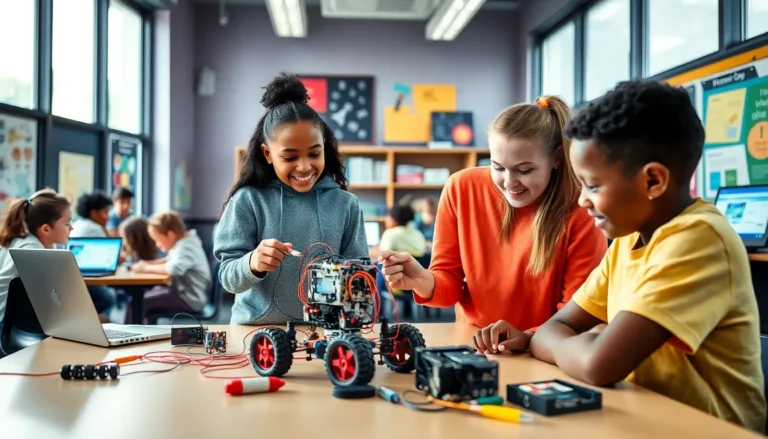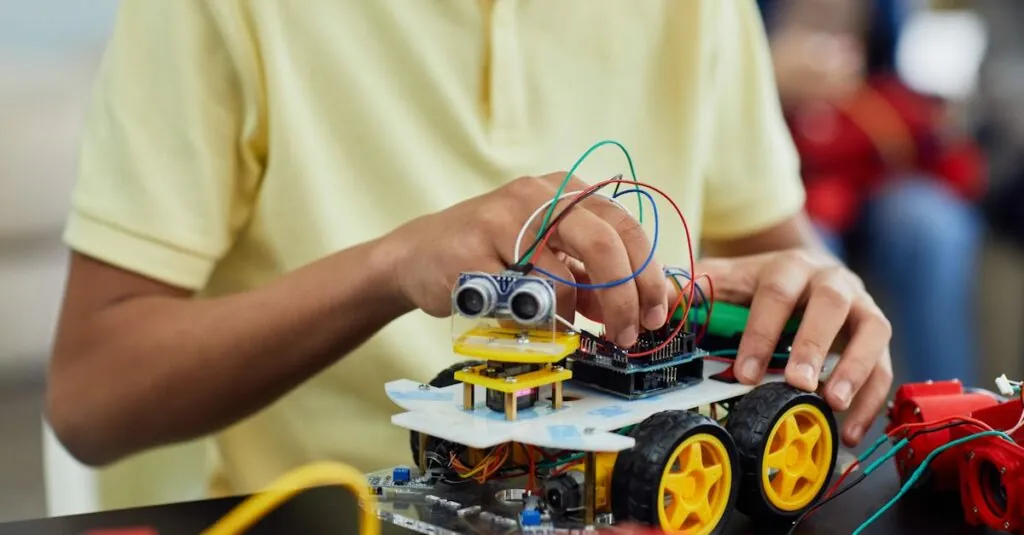Table of Contents
ToggleSTEM projects for kids are like the secret sauce to sparking curiosity and creativity. Imagine your child transforming into a mini Einstein or a budding Marie Curie, all while having a blast! These hands-on activities not only ignite a passion for science, technology, engineering, and math but also keep those little hands busy and their minds whirring.
Overview of STEM Projects for Kids
STEM projects for kids offer multiple educational benefits. Engaging in these activities encourages critical thinking and problem-solving skills. Developing these skills at an early age can lead to a strong foundation in science, technology, engineering, and math disciplines.
Hands-on activities capture children’s attention. Examples like building simple machines or conducting experiments make learning enjoyable. Creativity often flourishes when kids explore concepts through practical application. This exploration can include programming a robot or designing a bridge using common household materials.
Collaboration enhances the learning experience. When kids work in groups, they learn to communicate and share ideas. Group projects like creating a model ecosystem can demonstrate teamwork’s importance in achieving common goals. These experiences prepare children for future collaborative environments.
Learning through play is a key principle in these projects. Incorporating fun elements keeps kids engaged and fosters a love for learning. Activities such as coding games or science fairs provide real-world connections to theoretical knowledge.
STEM projects also promote resilience. Experimenting with different approaches teaches children how to overcome setbacks. For instance, if a structure collapses during construction, kids learn to analyze what went wrong and refine their designs for better outcomes.
Parents and educators can easily access a variety of resources. Websites and community programs offer a plethora of project ideas suitable for various age groups. Choosing a project that aligns with a child’s interests can enhance motivation and engagement.
Exploring STEM projects enables kids to discover their potential. Exposure to these fields may ignite a passion that influences career choices later in life. Encouraging this exploration paves the way for success in an increasingly technology-driven world.
Benefits of STEM Education
STEM education offers numerous advantages that enhance children’s learning experiences. Engaging in STEM projects nurtures essential skills and encourages lifelong curiosity.
Enhancing Problem-Solving Skills
Problem-solving skills improve through hands-on STEM activities. Learners encounter challenges that require critical thinking. They analyze situations and develop solutions, enhancing analytical abilities. Such experiences foster persistence as children work through obstacles. Kids discover multiple approaches to solving problems, teaching them flexibility in their thinking. Engaging with real-world scenarios equips them to tackle complex issues confidently. Collaboration during group projects further strengthens these abilities, as students share diverse viewpoints and strategies.
Encouraging Creativity and Innovation
Creativity flourishes in STEM environments that promote exploration. Kids express ideas through design and experimentation, developing originality. They learn to connect concepts across disciplines, leading to inventive solutions. Hands-on projects spark enthusiasm, encouraging kids to take risks with their ideas. Emphasizing trial and error allows them to embrace mistakes as learning opportunities. Innovation springs from this freedom, as children apply what they learn in unique ways. Creating and testing prototypes fosters an inventive mindset, preparing them for future challenges in a technology-driven world.
Types of STEM Projects for Kids
STEM projects encompass a variety of activities that promote learning in engaging ways. These activities enhance critical skills while providing hands-on experience across different disciplines.
Science Experiments
Science experiments offer practical learning opportunities. Simple activities, like creating volcanoes using baking soda and vinegar, demonstrate chemical reactions effectively. Another example includes testing plants’ growth under different light conditions, which teaches botanical principles. Kids often enjoy experimenting with basic physics through building small rockets to understand propulsion. Through these experiments, children foster curiosity and gain insights into scientific methods.
Technology Innovations
Technology innovations inspire creativity and problem-solving. Building basic coding projects using platforms like Scratch allows children to create interactive stories and games. Robotics kits encourage learners to design and program their own robots, enhancing their understanding of programming concepts. Another technology project involves exploring simple app development, inviting kids to solve real-life problems through innovative solutions. Such projects help children appreciate technology’s role in everyday life while cultivating their digital skills.
Engineering Challenges
Engineering challenges engage kids in hands-on design and construction. Activities like building bridges with popsicle sticks teach structural integrity and teamwork. Another fun project involves designing and launching water rockets, which combines creativity with principles of aerodynamics. Constructing simple machines, like catapults, helps children understand motion and forces. These challenges encourage critical thinking, allowing kids to test their designs and maximize functionality.
Math Puzzles and Games
Math puzzles and games make learning enjoyable and interactive. Engaging in activities such as Sudoku or logic puzzles fosters critical thinking and pattern recognition. Children can also explore math through board games that involve counting or strategy, reinforcing numerical skills in a playful context. Creating math scavenger hunts around the house encourages kids to solve problems and enhance their math fluency. These activities demonstrate that math can be fun, stimulating interest in the subject while building foundational skills.
Tips for Successful STEM Projects
Successful STEM projects require careful planning and consideration. Prioritizing age-appropriate activities keeps kids engaged and motivated.
Selecting Age-Appropriate Projects
Choosing the right project aligns with children’s developmental stages. Younger kids benefit from simple science experiments that involve colors or reactions. Engaging in projects like building simple circuits captivates intermediate learners. Advanced projects, such as coding or designing complex structures, make sense for older students. Assessing skill levels ensures activities are challenging but not overwhelming, encouraging growth while maintaining interest.
Gathering Materials and Resources
Collecting materials is essential for a smooth project experience. Organizing supplies in advance helps prepare for hands-on activities. Everyday items such as cardboard, tape, and markers often work well for basic projects. Online resources provide numerous ideas, guiding project selection and material sourcing. Local stores and recycling centers can be valuable for unique items. Familiarizing children with gathering materials teaches responsibility and the importance of preparation.
STEM projects offer a dynamic way for kids to explore science, technology, engineering, and math. By engaging in hands-on activities, children not only cultivate essential skills but also develop a love for learning. These projects encourage creativity and critical thinking while fostering teamwork and resilience.
Parents and educators play a crucial role in guiding children through these experiences. With numerous resources available, they can easily introduce exciting challenges that spark curiosity. Embracing the trial-and-error process helps kids understand that mistakes are valuable learning opportunities.
Ultimately, investing time in STEM activities prepares children for a future where innovation and problem-solving are vital. By nurturing their interests today, they can pave the way for tomorrow’s discoveries.







